The concept of having the terrain in competitive 40k events set up, and even built, in a standardized format is nothing new. Many events, even small RTTs, have had a rough “template” they’ve followed when setting up tables for years. But how far should we go as a community, and what are the goals of such a policy?
SaltyJohn here from TFG Radio and one of the Head Judges for the Las Vegas Open bringing you my take on the concept of standardized terrain in Competitive 40k.
Before we dive into whether or not this is a good or bad idea on the level currently being debated online let’s talk a bit about the history of this idea, and what it really is. When abstract terrain was thankfully put to rest after 4th edition and true Line of Sight terrain rules became the norm a need for certain styles of terrain, and terrain setups became more necessary in competitive 40k events. One of the first changes we began to see was fewer forests and more large ruins. This was facilitated by GW releasing some really great Gothic ruins sets that could easily be built to stack up to a third level in terms of height. Still, we didn’t see too many built that way. TOs would still prefer single-story ruins, or perhaps two-story ruins. Along with the larger ruins, we began to see a push by players and TOs to ditch “planet bowling ball” made famous by Adepticon and put more terrain on the tables, with a key component. That key component we saw a lot of was a single large piece of terrain in the center of the board. This single large piece of LoS blocking terrain in the center of the board is the progenitor of the current table paradigm in competitive 40k. The Frontline Gaming Terrain sets are designed with this in mind, and the NOVA double Ls in the middle of the table are also apart of this paradigm. Games Workshop 40k streams and even their terrain is designed with this paradigm in mind. 40k players would be hard-pressed to find an event that eschewed this paradigm in any meaningful way, and there is little push from the community to shift it.
Near the end of 5th and beginning of 6th edition, many TOs began to adopt the idea that the corners, or table quarters, of the table, should have a decent-sized piece of terrain in each and those pieces should be aligned somewhat symmetrically. Creating a more standardized table layout at many events where the picking of deployment zone became less of a factor on the outcome of the game, but more of a factor in list design. When the players knew going into an event what sort of terrain placement to expect, and what type(s) of terrain would be used, it was easier to build lists to that specific terrain meta. This idea grew in popularity throughout the dark days of 6th and into the slightly brighter and more popular but still bloated doldrums of 7th. The shift of the 5th edition terrain paradigm to include the single piece of large terrain in each table quarter was reflected in most of the major 40k events by the end of 7th, and in the terrain sets being sold as full tables. Full table sets of terrain often included 1 large centerpiece, 4 smaller quarter pieces, and a few pieces of other “debris” type terrain like craters, signs, barricades, etc. Obviously not all events followed this terrain set up, some had more, some had less. The height(s) of terrain pieces and their “footprint” varied from event to event. Whether or not large ruins were mounted on a base or not also varied widely. Still the foundations of a standard had been set that would travel with us into 8th edition where we are at today.
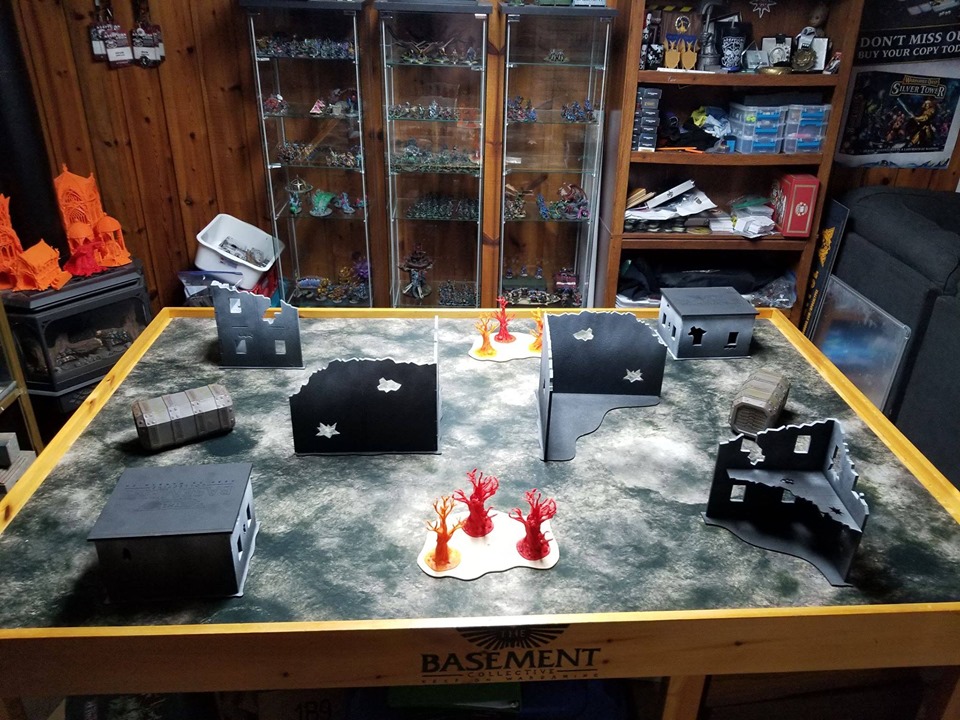
The catalyst for this dissertation on standardized terrain was a post in a popular Facebook group for competitive 40k players, called oddly enough: Competitive 40k. The post was made by someone basically advertising their standard terrain for sale, or for rent, it would seem to other TOs. You can check out the post yourself here. If you read through the 150+ comments you will no doubt see my response, some of which is found here, but in an expanded version. The basic idea of this terrain is to be relatively cheap, easy to build, easy to store, and ultimately easy to get onto the tabletop. You can, of course, add your own elements and change the configuration as noted by the OP. The conversation about what “Standard” 40k terrain should look like, or how it should be set up is an interesting one and is needed. As more events take cues from LVO and NOVA with their either somewhat standard to absolutely standard table, respectively, some real discussion is needed. While LVO and NOVA both have ideas on standard terrain on each table they take some different approaches. Newcomers Pro Table Top is even advocating for standard terrain and a standard mat with grid lines and designs to standardize play further.
Standardized terrain in 40k is an alright idea, but this particular brand of it is not. First, the type of terrain isn’t that aesthetically pleasing, while functional it leaves a lot to be desired when you put a fully painted and based army on it. Some of that certainly has to do with how it is painted, but it also has to do with the design. The thin, MDF board type terrain can be done well, but when you’re just using it to create really simple, tall walls in L shapes it is less than great. Warhammer 40k is first and foremost a hobby. That hobby is reliant on creating a game that isn’t just fun to play but an experience that is fun to see, pleasing to the eye. It’s one of the reasons players pushed so hard for there to be painting standards at events, also one of the reasons the vote for having ITC Faction awards go to “pure” armies only was so popular. The aesthetic element of the game really matters. The same goes for esports too, since that is the most commonly drawn similarity. The best, and most popular, esports games all take place on maps/levels with varied and well-done graphics. Playing 40k on boring terrain is, well, boring. The real issues with this idea isn’t the aesthetic style but the thematic style of standardized terrain, where it is the same terrain arranged in the same manner on every table at the event is two-fold. First it’s boring to play on the same table set up 3-9 games in a row, and second, it removes an entire facet of the strategy and skill from the game.
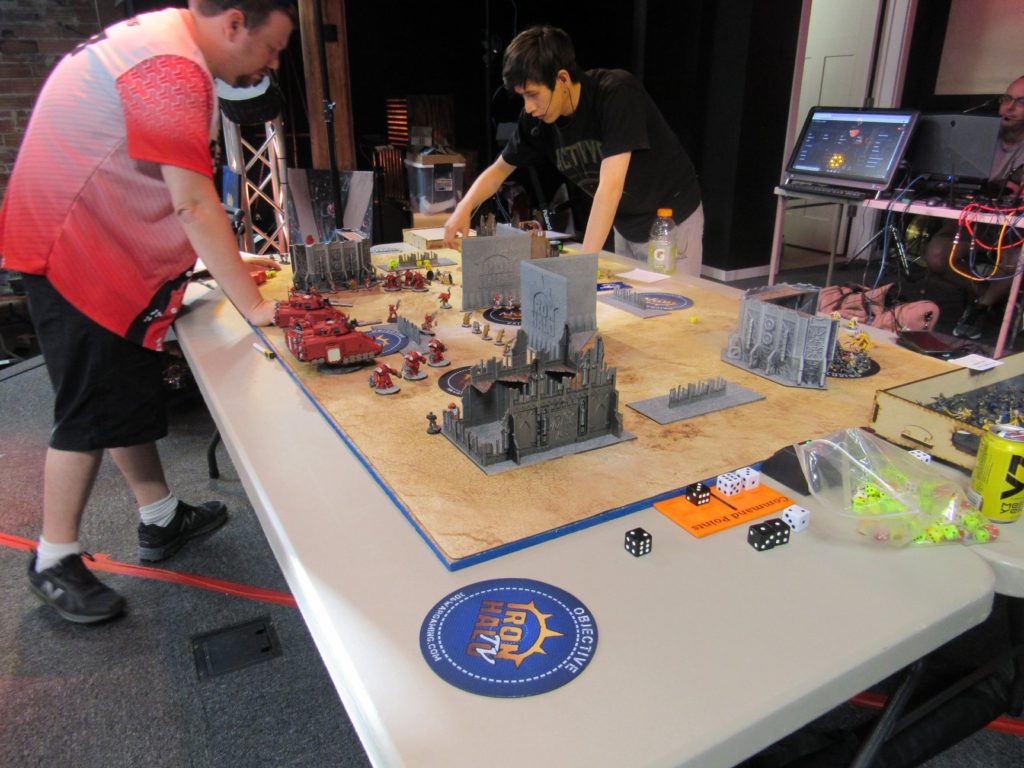
I understand the draw of the NOVA Double L and the desire to use them for advertising, but it creates a stagnant play experience.
The more you standardize the game the more you take away from it in terms of player skill. 40k is predominantly a game of decision making that’s given a random element through dice. Learning to recognize and capitalize on your opponent’s mistakes while simultaneously mitigating or preventing your own, is one of the keys to becoming a really good 40k player. Playing armies that mitigate the random element(s) of the game has also always been a key to success in 40k, some of the historically strongest armies in 40k have been those that provided a mechanic to negate poor rolling or poor choices. Re-rolls, counter deployment, and extra movement have always made an army powerful. It’s one of the reasons for Ynnari and Eldar dominance in the past. Removing chance makes the game easier to play and more forgiving by allowing players to correct their mistakes. By standardizing every table to a single set up you are removing a large part of the decision making aspect of the game, pushing the deciding factors of each match towards the random elements like dice rolls and away from the player’s mistakes. That is just plain bad for the game as a whole. These are the same issues I have with the Pro Table Top format that was discussed fervently online about a month ago but seems to have disappeared now. The push toward a single, standard, table set up is a mistake. Even if you’re looking at this from an esports angle, or the angle that it needs to be more accessible to the “masses” (no 40k event streamed so far has had over 1000 viewers at once except the LVO), this idea still makes little sense.
If we are going to think of 40k in esports terms then the analogous game to look at isn’t League of Legends with its single map, it is Starcraft 2. Starcraft 2 is also a decision-based strategy game, albeit with a lot less random elements involved, but it is played between two players (competitively) like 40k. They have standardized maps, plural, and basic starting points. However, the standardized maps are all designed differently and although a player has an idea of how they might play each map given their match up the random element of your opponents’ decisions and how to react makes each game different. If Starcraft 2 used a single standardized map it would have little success as a competitive game let alone be a fun game. It would be boring, you could solve it easily. That is ultimately what we need to avoid with the idea of standardized terrain in 40k, boredom and making the game more reliant on random dice and less about player choices. That said, what we should strive for with standardized terrain in 40k is a Starcraft 2 style set up. Several, perhaps 4-8, standardized and varied setups. Temple ruins, Imperial urban, Necron, Tyranid, Ork, Chaos, Tau, whatever you like. Pick 4-8, make the terrain, create a standardized set up for each varied type and go from there. Now, this also opens up the discussion into how the terrain should be set. The NOVA double large Ls in the center is fine for some games, but not every game. Creating varied tables with decent Line of Sight blocking terrain in the center and on the periphery is important, but every table being big double Ls is boring, and again creates a situation where you can “solve” it and therefore leave more of the game open to being decided by dice, not skill. We shouldn’t as a community rush to embrace simple, easy to build, easy to paint standardized terrain simply because it is easy, or easy to place your tournaments logo on for stream advertising. The ramifications of adopting such a format go far beyond the bottom line for the organizer and that factor, the game experience factor, is what actually matters.
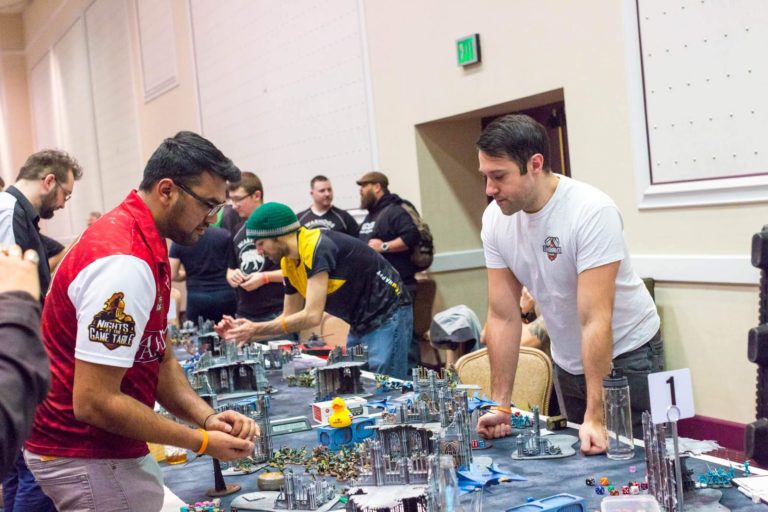
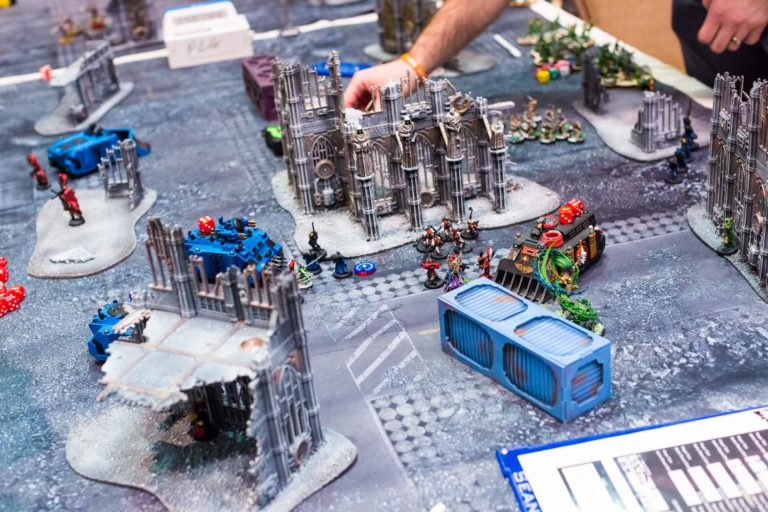
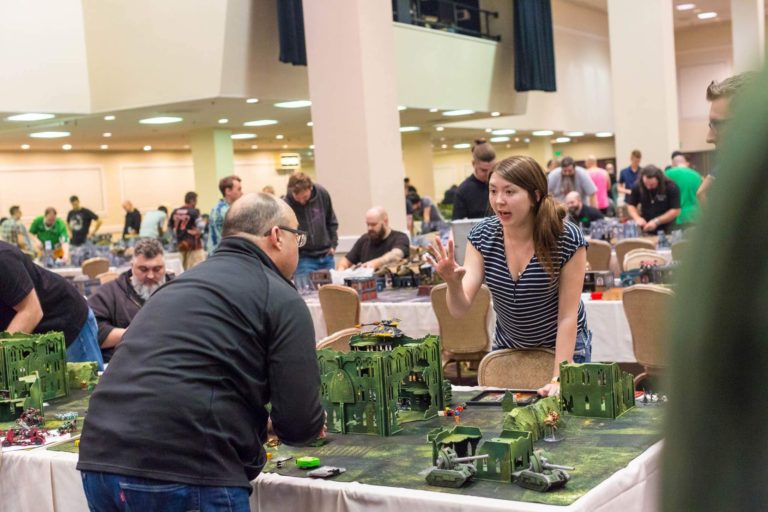
The photos above do a good job of showing how you can have a standard terrain setup that is also varied enough to not be boring.
When adopting any policy a good tournament organizer, or judging staff, should place a premium on the gameplay and event experience of the average player. The average player pays the bills with their attendance. The average gamer will grow or destroy, an event through their attendance and the attendance of their friends and other people they let know about the event and their experience. Competitive 40k, particularly the ITC and Las Vegas Open, haven’t seen a huge boom in numbers thanks to them catering to what the top 10% of players want. It has grown by doing what the average players want and listening to them. The same care to cater to the needs of the average player needs to be taken into account with the determining “Standardized Terrain” policies as is taken for things like space between tables, venue, start times, round times, conversion and paint policies etc. Most people attend big 40k events to play games against good opponents and have fun, while maybe holding out hope for a prize of some sort. Most players are not coming with the intent of playing hyper cut-throat, uber-competitive 40k games where every nuance of terrain and the related rules for it will make or break their chance for “glory”. Standardized Terrain setups where every table is exactly the same caters to the latter group, not the former, and that is not good. Most players want to play on terrain that looks good, and makes sense, but is also fair. You can do that in competitive 40k but it isn’t with these cookie-cutter setups that are currently being advocated, nor by the same exact terrain set up on every table.
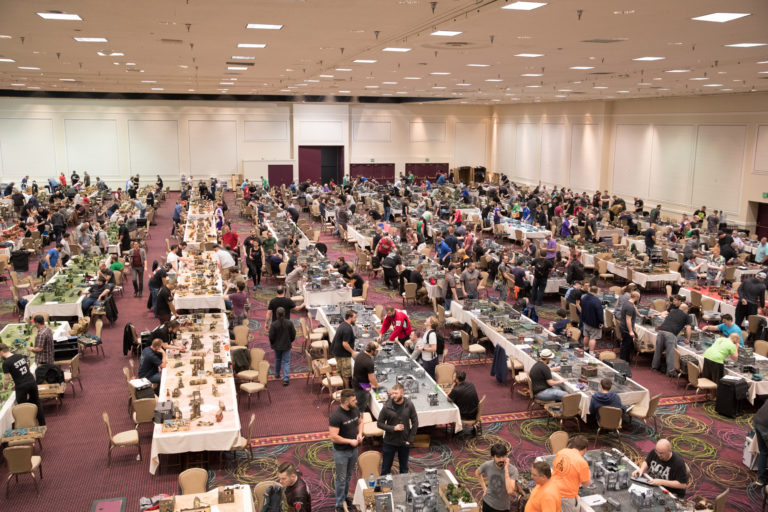
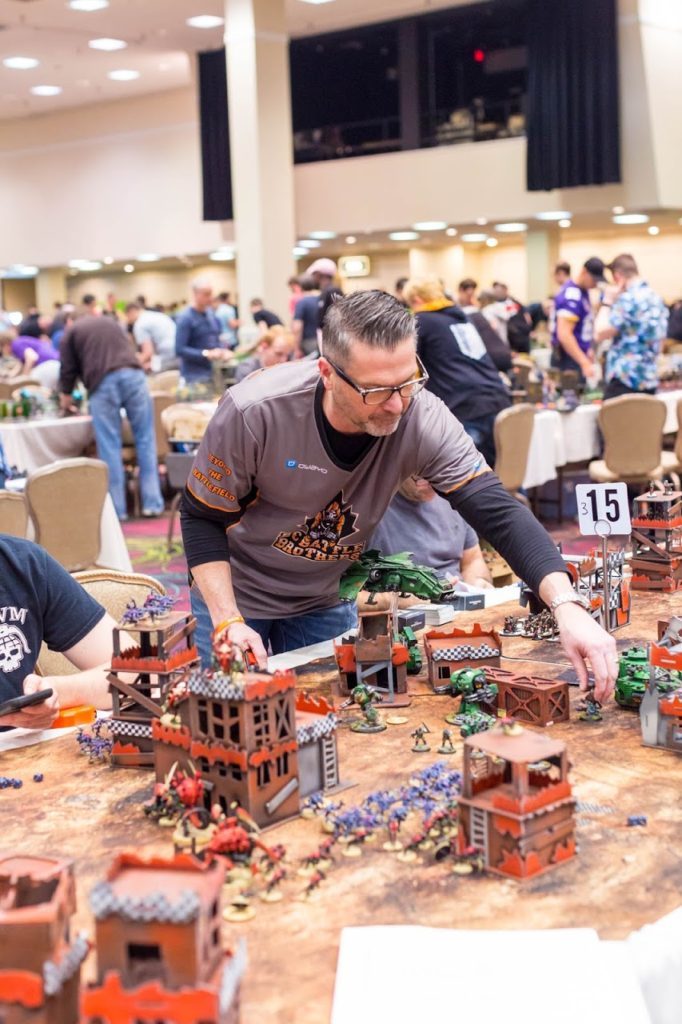
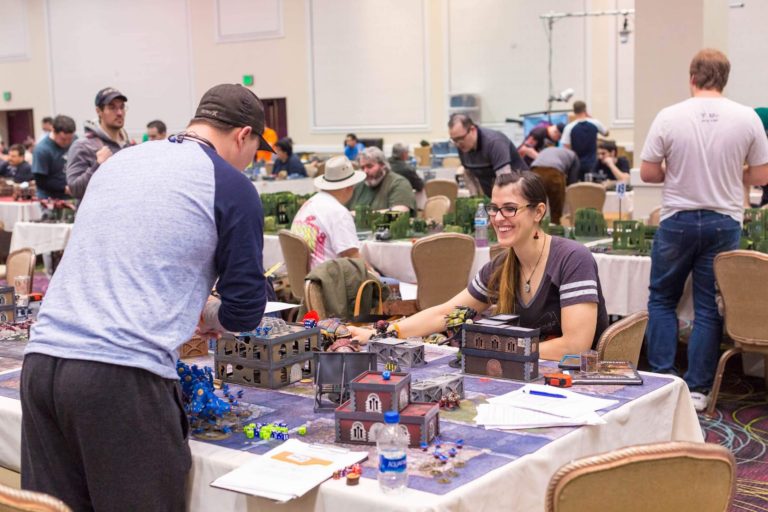
Again these photos demonstrate that creating standard terrain setups that are varied is possible, it costs money, but your attendees are paying you to provide an enjoyable experience, not just a competitive one.
Having 4-8 standard sets of well-done terrain, with a standard set up for each type, is the way to go. This way you can group the tables by type, the players know what to expect from each type, but they won’t know every single round will be the same. It makes the players, and the judges, lives easier; without removing too much of the player skill factor that terrain puts into the game. It also allows for variation in theme and style between games which creates a more pleasing gaming experience aesthetically while still holding to a standard enough template that the game remains competitive. Playing the same map every game isn’t the direction competitive 40k should take, and although running an event is expensive your average player, the one who pays your bills, ultimately wants an aesthetically pleasing event not a snoozefest round after round. For those TOs out there reading this who are ardently behind the idea that growing the online audience is where the money is at, I can tell you the audience doesn’t want to watch the same terrain set up game after game either. If you need evidence, check the Twitch chats from round 3 and up for events that don’t change the board the stream games are on at all. The audience for esports events like Overwatch or Starcraft 2 would be disappointed if every match was played on the same map. The 40k audience desires the same variety in their viewing experience.
So what do you think? Should 40k tournaments move to a standard terrain set up for every table, or should they move towards a set of standard tables that still provide variety? Let me know in the comments.
And remember, Frontline Gaming sells gaming products at a discount, every day in their webcart!


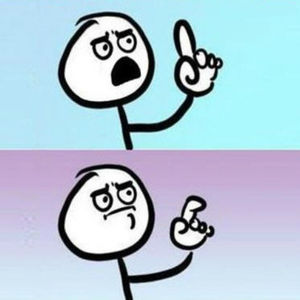
agree 100% standard terrain setups is bad for the game, what should be more standards is Number of pieces/types of pieces in different layouts, so you dont get some tables with all forests/no ruins etc.
Yes, like a modular template, would be good for this. Not a single standard table, but multiples steups, or a modular template that has basic standards/expectations.
Very good points, John. I agree wholeheartedly that the game has to keep it’s roots in mind: it is a hobby. We were all drawn to it for the cool story and beautiful models. Going away from that will alienate the average player.
Having good looking terrain creates a much more enjoyable and engaging play experience and it’s a lot better for recruiting new players to the hobby as well.
Although, haha, I much prefer abstract terrain rules as we had in 4th for matched play. It’s just so much easier. True LoS is great for narrative and open play but for competitive play at least partially abstract terrain rules facilitates smoother game-play.
*Triggered in abstract terrain rules*
I agree that having several setups, rather than one exact type for every game, is better. However, I also do really like the NOVA terrain and the big L-shapes as I feel like it would lead to a more fair game than ITC terrain.
After doing the ITC/FLG terrain at a lot of RTTs and bigger events the past few years, I’ve really come to regret its popularity because I feel it does too little to block LOS and allow some covered movement around the board. The GW terrain or the cut-up NOVA terrain both do a much better job of providing height and sometimes width. While I appreciate the solid LOS blocking on the first floor with ITC, one medium 2-3 story building in the middle and then a 1 or 2 story small-ish building in each corner, plus some small crates around the board, don’t provide much LOS blocking at all. Especially if you need to move around the board at all (usually the case).
I miss the old terrain I used to see at events and gaming stores, i.e. mountains, big walls, big 3-story hills, etc. I feel that 8th edition really compounds the shortcomings of ITC terrain because shooting is such a beast with the offensive output and rerolls we see these days. I would rather have slightly less pretty terrain that leads to less alpha striking and more tactical movement than slightly more pretty terrain that leads to sub-optimal gaming experiences in a lot of matchups.
A mix of terrain styles and types is necessary. Using all one type or another is not ideal.
Nova terrain is actually pretty bad, on 4/6 maps the terrain effectively has 0 LOS blocking as you can just shoot around it, only on corner maps do you get any LOS blocking from L’s. The lack of any real ruins anywhere outside the L’s or any other Los blocking means shooting armies do really well on Nova.
That’s funny you say that as I played my shooty army at NOVA on Vanguard deployment and the large L’s cut off LoS to like, 75% of the table as the angle was perfect. I could only see the extreme sides of the table, lol, completely shut down my ability to shoot anything. I had to charge up the table and go into melee with Devastator marines and such, haha. It was pretty funny.
That is why i said only on corner maps do the L’s actually block LOS for 1st turn etc. On any of the non corner deployments though, you actually get very little LOS blocking outside of the L’s, nothing else on the tables really blocks well and the “ruins” they use for corners are full of holes/don’t block LOS.
True. And on the corner maps I think it actually blocks TOO MUCH LoS. I literally couldn’t see anything in a like 4′ wide stretch, haha. It was crazy.
Now, don’t get me wrong, NOVA terrain is highly functional and there’s a reason so many events copy it (as it’s also very easy to make). But, I think you need a little less girth on the L’s (for lack of a better descriptive word, haha) and a little more LoS blockers on the sides of the tables. But, that’s just me.
Too much girth on the L usually means a bad time, just saying.
lol
I agree, Mike will do his thing, I like the L’s and the idea of set terrain but just wish they were a little less impactful and rest of the terrain did more.
Maybe the answer is having an unequal terrain set up. Give the player with the second turn slightly better/more defensible terrain to help mitigate the damage done on the first turn.
I’m sure there is someone in the community capable of figuring this out, lets use the powers of mathhammer for good for once.
Some of our tables are intentionally non-symmetrical for that very reason.
Which terrain set are you talking about, though? Each one we make is very different. You can’t really say “ITC terrain is X or Y” as each set varies quite a bit. However, if you use the sets the way we suggest, the table has a TON of coverage. If someone just picks up a couple of buildings and calls it an ITC Terrain set, that may not reflect the way we intended it to be used.
Symmetrical terrain removes the advantage of being able to choose table sides, which further exacerbates the “I won the roll therefore I lost the game” problem with the current deployment method.
Yep! There needs to be a happy medium between completely symmetrical terrain placement and completely imbalanced setups.
“I feel that 8th edition really compounds the shortcomings of ITC terrain ”
@ Nick Wenker
I think you missed the point of ITC terrain’s main feature: ground level LOS-blocking.
This hobbles the 8e heavy shooting, as you put it, “shooting is such a beast with the offensive output and rerolls we see these days.” Now, with several ITC pieces on the table, troops can hide mitigating the 8e powerful shooting element.
@SaltyJohn
Great article. Reading collegiate level writing is like eating a Ruth’s Chris steak.
Awwww, thanks, man.
Even in 5th I saw plenty of area terrain, cliffs/hills high enough to BLOS for things on ground level, and even things like rivers and roads. Wish we could see that kind of variety come back.
I don’t know where I stand on double Ls vs one big pice vs some other solution. Though I do wish instead of magic boxes there were occupiable (and destroyable) neutral buildings.
The only issue with destructible buildings (and I really like it in DzC for example) is that in 40k what the heck do you do with the building when it is destroyed? In DzC you take it off and replace it with a rubble pile but with big 40k buildings that’s not really a viable thing to do in a big event. The terrain will inevitably get lost/broken.
All this talk of better more LOS blocking terrain is just Reeces way of screwing over Tau again.
Lol, they’re on to me!
This was a really interessting and good read. I think your starcraft 2 multiple map analogy is spot on. 4-6 different terrain styles would be enough to add the variety required for the average hobbyist going out. Some could be symmetrical others assymetrical. TOs just set up the tables in euqla quantities of each basic template and let your seeding determine which map you play on for that match.
I think it would add a lot of flavour and a depth to the competitive nature not detract from it.
Thank you. Yeah, I agree, that was how the Las Vegas Open was set up last year and it worked really well.